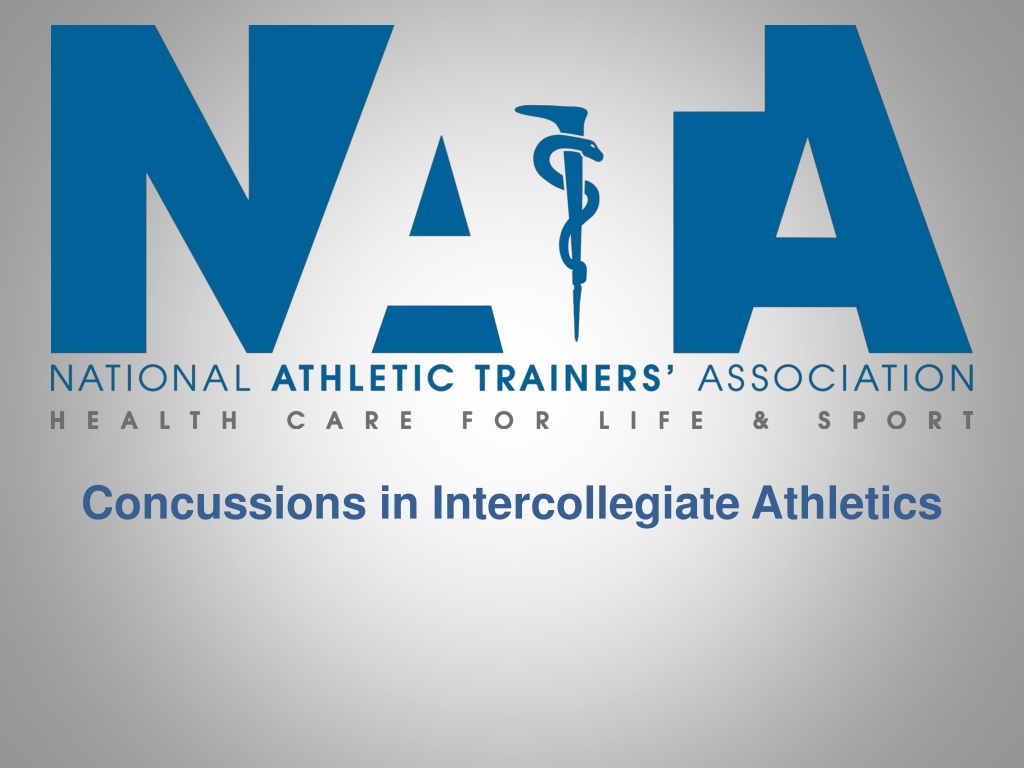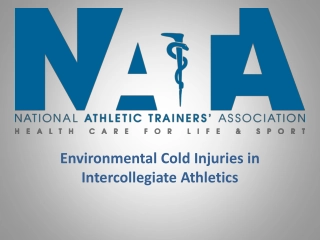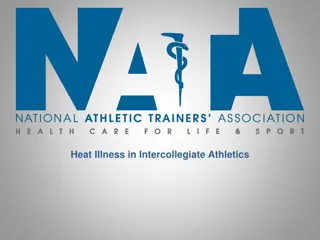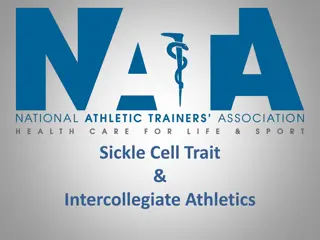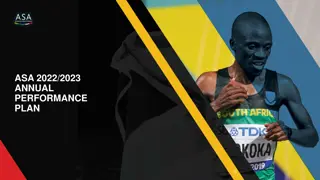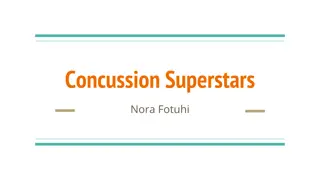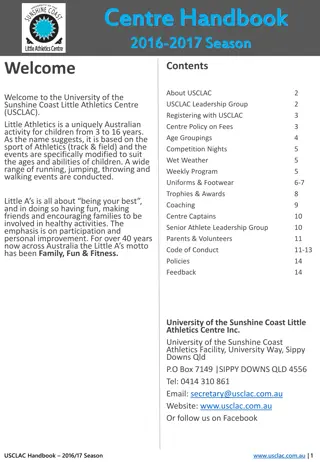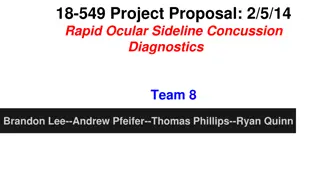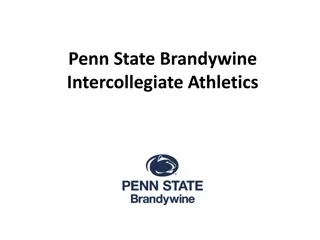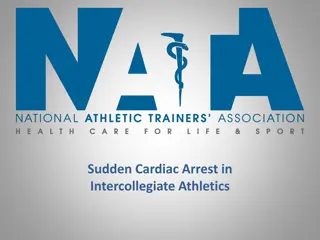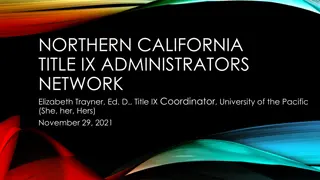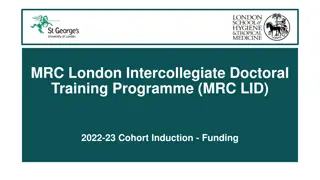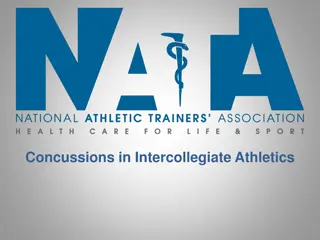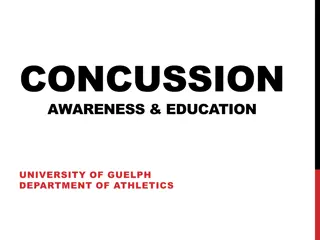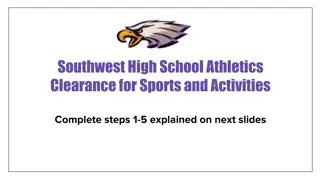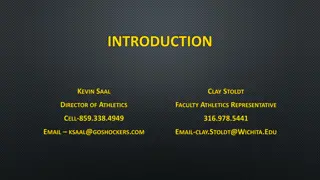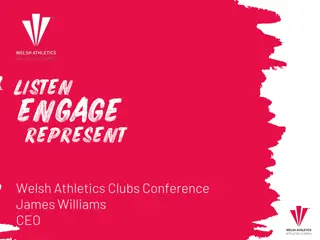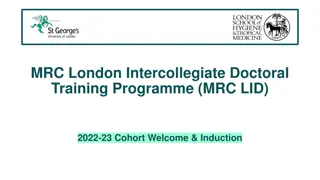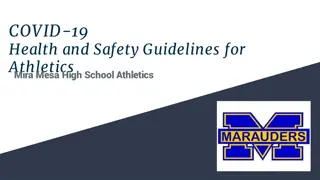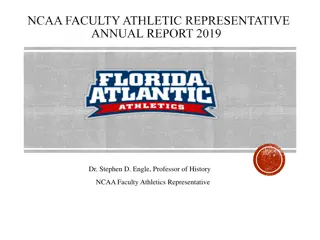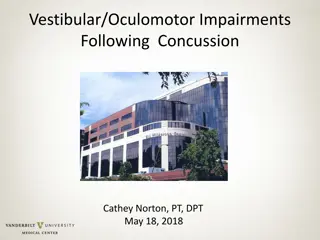Concussion Management Guidelines in Intercollegiate Athletics
Concussion management in intercollegiate athletics involves educating student-athletes about signs and symptoms, implementing protocols for removal and evaluation, and ensuring proper medical clearance before return to activities. It also includes baseline testing, education on concussions, and annual review of procedures. Institutions must have a concussion management plan and comply with safety protocols for student-athlete welfare.
Download Presentation

Please find below an Image/Link to download the presentation.
The content on the website is provided AS IS for your information and personal use only. It may not be sold, licensed, or shared on other websites without obtaining consent from the author. Download presentation by click this link. If you encounter any issues during the download, it is possible that the publisher has removed the file from their server.
E N D
Presentation Transcript
Definition Definition Sport related concussion is a brain injury caused by a direct blow to the head, neck or body resulting in an impulsive force being transmitted to the brain This initiates a neurotransmitter and metabolic cascade with possible axonal injury, blood flow change and inflammation affecting the brain Signs and symptoms may evolve immediately, over hours or days and commonly resolve within days but may be prolonged
Concussion Management Guidelines An active member institution shall have a concussion management plan for its student-athletes The plan shall include, but is not limited to, the following: An annual process that ensures student-athletes are educated about the signs and symptoms of concussions Student-athletes must acknowledge that they have received information about the signs and symptoms of concussions and that they have a responsibility to report concussion-related injuries and illnesses to a medical staff member
Concussion Management Guidelines A process that ensures a student-athlete who exhibits signs, symptoms or behaviors consistent with a concussion shall be removed from athletics activities (e.g., competition, practice, conditioning sessions) and evaluated by a medical staff member (e.g., sports medicine staff, team physician) with experience in the evaluation and management of concussions A policy that precludes a student-athlete diagnosed with a concussion from returning to athletics activity (e.g., competition, practice, conditioning sessions) for at least the remainder of that calendar day A policy that requires medical clearance for a student-athlete diagnosed with a concussion to return to the athletics activity (e.g., competition, practice, conditioning sessions) as determined by a physician (e.g., team physician) Procedures for preparticipation baseline testing of each student-athlete Procedures for reducing exposure to head injuries
Concussion Management Guidelines Procedures for education about concussion, including a policy that addresses return-to-learn Procedures to ensure that proper and appropriate concussion management, consistent with best known practices is made available to any student-athlete who has suffered a concussion Procedures requiring that the process of identifying, removing from game or practice and assessing a student-athlete for a possible concussion are reviewed annually NCAA Institutions: A written certificate of compliance signed by the institution s athletic director Information to Concussion Safety Protocol Committee: An institution shall provide information to the Concussion Safety Protocol Committee, as the committee may request, concerning any incident in which a student-athlete may have suffered a concussion
Concussion Education Insert your own institutional methods of student-athlete, coaches and administration education on reporting symptoms and personal responsibilities Consider using the most updated Consensus Statement on Concussion in Sport, NATA resources, NCAA resources, CDC or any other scientific evidence when developing your education materials Consider using the NCAA Inter-association Consensus documents for year-round football practice contact for college student-athletes recommendations for practice parameters that address safety and head impact exposure in football
Concussion Identification/Management Institutional Methods for Identifying Possible Concussions Insert methods used by your institution to identify potential concussions and specific tests All student-athletes who are experiencing signs, symptoms or behaviors consistent with a sport-related concussion, at rest or with exertion, must be removed from practice or competition and referred to an athletic trainer or team physician with experience in concussion management
Concussion; Signs & Symptoms Table 2: Selected acute & delayed signs & symptoms suggestive of concussion Cognitive Somatic Affective Sleep Disturbances Confusion Anterograde amnesia Retrograde amnesia Loss of consciousness Disorientation Feeling in a fog , zoned out Vacant stare Inability to focus Delayed verbal & motor responses Slurred/incoherent speech Excessive drowsiness Headache Dizziness Balance disruption Nausea/vomiting Visual disturbances (photophobia, blurry/double vision) Phonophobia Emotional lability Irritability Fatigue Anxiety Sadness Trouble falling asleep Sleeping more than usual Sleeping less than usual Team Physician Consensus Conference, Herring et al, 2011
Concussion Management Home Care Guidelines Following a Concussion Insert your institutional recommendations for student-athlete home care and monitoring following a concussion
Concussion Management Recommendations for Exercise Best current evidence recommending strict rest following complete resolution of symptoms is not recommended Clinicians are encouraged to recommend physical activity 24-48 hours following concussion as tolerated, avoiding the risk of contact, collision or fall Exercise may systematically advance based upon no exacerbation of symptoms with previous day s activities
Return to Learn Reduced screen usage the first 48 hours after concussion may be useful but is not effective beyond 48 hours 93% have full return to academic load within 10 days Early return to daily living activities should be encouraged as long as symptoms are only mildly increased Work with necessary campus and medical personnel to develop your specific institution RTL guidelines
Return to Sport Insert institutional recommendations for step-wise return to play criteria modeled after the most up to date Consensus Statement on Concussion in Sport, NCAA Concussion Safety Protocol, NATA Position Statements and/or other supporting evidence Step 1 of the exertional protocol may begin within 24 hours of injury with progression through each step usually taking 24 hours Steps 4-6 should be monitored closely by a health care professional and not begin until resolution of symptoms and full return of cognitive function
Return to Sport Exercise Progression Step 1: Daily activities that do not significant increase symptoms Day 2: Light aerobic exercise Day 3: Sport specific activity away from team environment Day 4: Non-contact training drills Day 5: Full contact practice Day 6: Return to Play
Considerations Referral to clinicians should be considered with persistent symptoms May include management of cervicogenic symptoms, migraine, headache, cognitive and psychological difficulties, balance disturbances, vestibular signs and oculomotor manifestations Symptoms greater that 4 weeks may be pre-existing, concussion related or both If dizziness, headaches or neck pain persist for longer than 10 days than cervicogenic rehabilitation is recommended
Medical Retirement Decisions regarding retirement or discontinuing contact/collision sports are complex and multifaceted and should involved a multidisciplinary team with the student-athlete Discussion should provide the student-athlete with scientific evidence and uncertainties of their condition balanced against the benefits of sport participation Decisions should incorporate the student-athletes preferences and risk tolerance as well as psychological readiness to make informed decisions
NCAA Concussion Policy and Legislation Arrington Settlement Requires pre-season baseline testing for all student-athletes and does not specify it as a one time obligation Advise institutions to review baseline testing protocol with general council for advisement on frequency, specific testing areas
NCAA Concussion Policy and Legislation Arrington Settlement Presence of medical personnel during competition medical personnel with training in the diagnosis, treatment and management of concussion are present at all Contact Sports* games for Divisions I, II and III Present is defined as being on-site at the venue of competition Contact sports defined as: football, lacrosse, wrestling, ice hockey, field hockey, soccer, and basketball, pole vault, wresting, skiing; whether a men s or women s team
NCAA Concussion Policy and Legislation Arrington Settlement Presence of medical personnel during practice medical personnel with training in the diagnosis, treatment and management of concussion are available at all contact/collision sport practices be available means that, at a minimum, medical personnel can be contacted at any time during the practice via telephone, messaging, email, beeper or other immediate communication means Contact/collision sports: acrobatics and tumbling; Alpine skiing; baseball; basketball; beach volleyball; diving; equestrian; field hockey; football; gymnastics; ice hockey; lacrosse; pole vault; rugby; soccer; softball; volleyball; water polo; wrestling.
NCAA Concussion Policy and Legislation Division 1 Transformation Report Presence of medical personnel during practice medical personnel with training in the diagnosis, treatment and management of concussion are available at all contact/collision sport practices be available means that, at a minimum, medical personnel can be contacted at any time during the practice via telephone, messaging, email, beeper or other immediate communication means Contact/collision sports: acrobatics and tumbling; Alpine skiing; baseball; basketball; beach volleyball; diving; equestrian; field hockey; football; gymnastics; ice hockey; lacrosse; pole vault; rugby; soccer; softball; volleyball; water polo; wrestling.
Recommendations Athletic trainers should work with the team physicians and risk management per the newly released 6th International Consensus Statement on Concussion in Sport and other national or conference regulations in revising their concussion management guidelines
References Consensus statement on concussion in sport: the 6th International Conference on Concussion in Sport Amsterdam, October 2022 | British Journal of Sports Medicine (bmj.com) Concussion Safety Protocol Management - NCAA.org
References Legislative Services Database - LSDBi (ncaa.org) Nov2019SSI-CMPArringtonFAQ.pdf (ncaaorg.s3.amazonaws.com) Consensus Statement on Concussion in Sport http://www.nata.org/sites/default/files/attr-44-04-434.pdf Year Round Football Practice Contact Recommendations http://www.ncaa.org/sites/default/files/Year%20Round%20Football%20Practice%20Contact%20Recommendations_2017011.pdf Management of Sport Related Concussion http://www.nata.org/sites/default/files/MgmtOfSportRelatedConcussion.pdf
